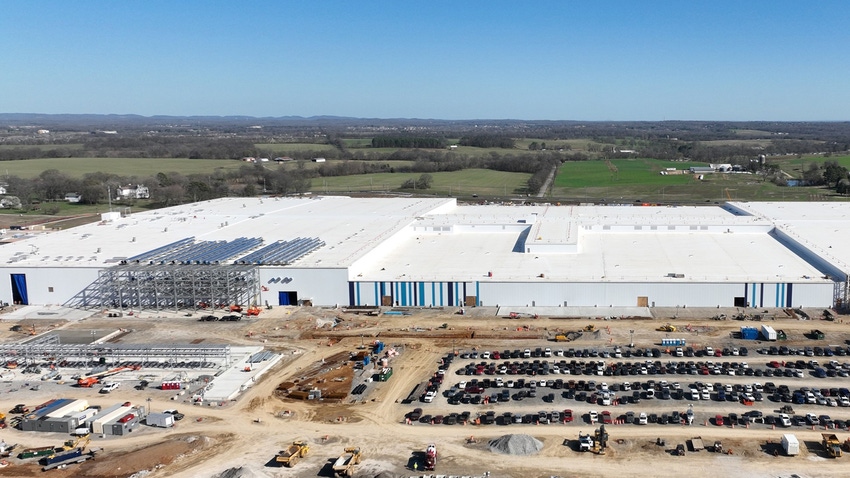Powering Up EV Battery Plant Design
Expert designers from Gresham Smith look at five key mechanical system considerations when planning a battery plant.

In the realm of electric vehicle (EV) battery manufacturing plants, the need for speed and the rigidity of fixed project completion dates inevitably gives rise to aggressive and challenging timelines. Transforming these tight timelines into a reality demands meticulous attention to detail on behalf of the design team.
Before delving into the intricate design of critical mechanical systems, there are several key factors that require careful evaluation and inclusion in the planning process. These considerations encompass the need for a clear understanding of stakeholder expectations, planning ahead for all spaces within the facility, an acute awareness of the multitude of variables at play, and the incorporation of redundancy and optimization through continuous improvement of the design.
In this article, we explore these key mechanical system considerations, recognizing their role in distinguishing between a successful project and one that is fraught with setbacks that can extend far beyond the confines of the project timeline.
Understanding stakeholder expectations
Identifying and understanding owner-related expectations early on will create a clear road map to guide the project. Effective communication with stakeholders—of which there can be many when designing an EV battery manufacturing facility—is key. If a stakeholder, for example, presents a solution to the design team without clearly defining the problem or expected outcomes at the onset of the project, it can lead to confusion and potential setbacks. To avoid this, it is essential to establish a clear understanding of the problem, what the desired solution should achieve, and the potential consequences of implementation—or lack thereof. By aligning both expectations and objectives up front, the design team can work collaboratively with stakeholders to develop effective solutions that not only meet the project’s goals but also minimize future disputes and promote a smoother design and construction process.
Plan For all spaces within the facility
Planning for all the spaces within an EV battery manufacturing facility early will reduce design and construction bottlenecks and eliminate rework and potential construction delays. It’s important to note that the owner’s intimate understanding of their processes and workflow is a valuable resource. Collaborative engagement with the design team not only allows the owner to communicate critical information, such as the specific spaces and personnel required to support the processes, but also sheds important light on the logistical journey—from raw materials entering the facility to the finished product exiting at the other end.
Gather complete and accurate records of hazardous chemicals and materials along with their safety data sheets. This is where transparency is key. If the design team lacks a complete understanding of the entire inventory of hazardous substances, as well as their storage and usage practices and overall flow within the facility, it is impossible to ensure comprehensive protection for both the plant and its personnel under all circumstances. Additionally, obtaining the necessary permits from the fire marshal and building authority hinges on having all the requisite information to guarantee the facility’s safe operation.
The complete set of variables
Plan for future growth. Anticipating and planning for future growth is key to achieving successful outcomes. Whether it’s considering expansion or system enhancements, or even addressing operational variations early on, a well-thought-out strategy is essential. One proactive approach to setting the stage for future success is to hold a master- planning session focused on a facility’s processes and operations. Conducted at the project’s outset, this session offers a critical glimpse into the facility’s future growth needs. Moreover, it equips the design team with invaluable insights into the client’s long-term requirements, empowering them to strategize and prepare with precision for these evolving demands.
From day one to full buildout, it is essential to understand how future growth will be phased. This is especially important when it comes to components such as cleanrooms and dryrooms, where it is imperative to ensure uninterrupted operations while adding additional process equipment within these areas.
Many critical systems within an EV battery manufacturing plant, such as precision equipment and automated assembly lines, operate within specified temperature ranges. Therefore, it is critical to coordinate design criteria to align with these temperature requirements. This not only helps to avoid the loss of critical systems, but also enhances safety, improves energy efficiency, and ensures the long-term operational reliability of the plant.
Plan for “soft landings.” To successfully navigate the unpredictable nature of real-world conditions such as extreme weather, it is imperative to adopt a design approach that is both robust and resilient while proactively preparing for what is often termed a “soft landing.” This involves conducting a thorough risk analysis right from the project’s conception, encompassing strategies that facilitate a graceful response to unexpected challenges. By identifying the most vital components of an operation early in the process, it becomes more feasible to make recommendations, such as modifying or adding essential equipment, or even make corrective actions if needed.
Redundancy in critical systems
The consequences of a single point of failure in an EV battery manufacturing plant can be catastrophic, potentially resulting in millions of dollars of losses. For this reason, critical systems should be designed with redundancy top of mind. While the up-front cost of incorporating redundancy measures may seem significant, it is a strategic investment in risk management. Deferring these costs at the beginning of a project can lead to greater expenses down the road. For example, when a failure occurs without redundancy in place, the costs can quickly accumulate due to production stoppages, loss of product stockpile, emergency repairs, rush orders for replacement parts and even potential damage to a plant’s reputation. In contrast, redundancy measures are a proactive expenditure that can result in long-term cost savings by preventing or minimizing the financial impact of failures.
Optimization through continuous improvement
Consider monitoring and maintaining systems before design begins so they can be monitored, commissioned, and maintained after installation.
Continuous commissioning is recommended for preventing long-term issues within a plant. By continuously monitoring and maintaining conditions inside the facility, problems can be identified and addressed as soon as they arise, rather than waiting until they escalate into critical failures that result in the loss of a critical system. This preventative approach is invaluable in terms of both cost savings and operational efficiency. Addressing issues as they emerge helps plant owners get the most out of their investment by avoiding the financial repercussions of costly breakdowns, production downtime and the need for emergency, higher-priced repairs or component replacements.
The foundation for success
When embarking on the design of an EV battery manufacturing plant, especially when focusing on mechanical systems considerations, it is imperative to lay the groundwork for success through a forward-thinking approach. Instead of rushing headlong into construction with a “build-something-now” mindset, it is crucial to prioritize a holistic perspective that maintains a clear focus on the end goal. Given that even minor oversights can jeopardize a project of this magnitude, every facet of the process demands meticulous attention. Early and comprehensive planning, with active involvement from all stakeholders, is not only a proactive means to sidestep potential pitfalls but is also a guarantee of a more seamless journey toward a facility’s final completion.
Michael Collarin is a senior mechanical engineer and Jonathan Woodside is a project executive; both are employed by Gresham Smith.
About the Author(s)
You May Also Like



